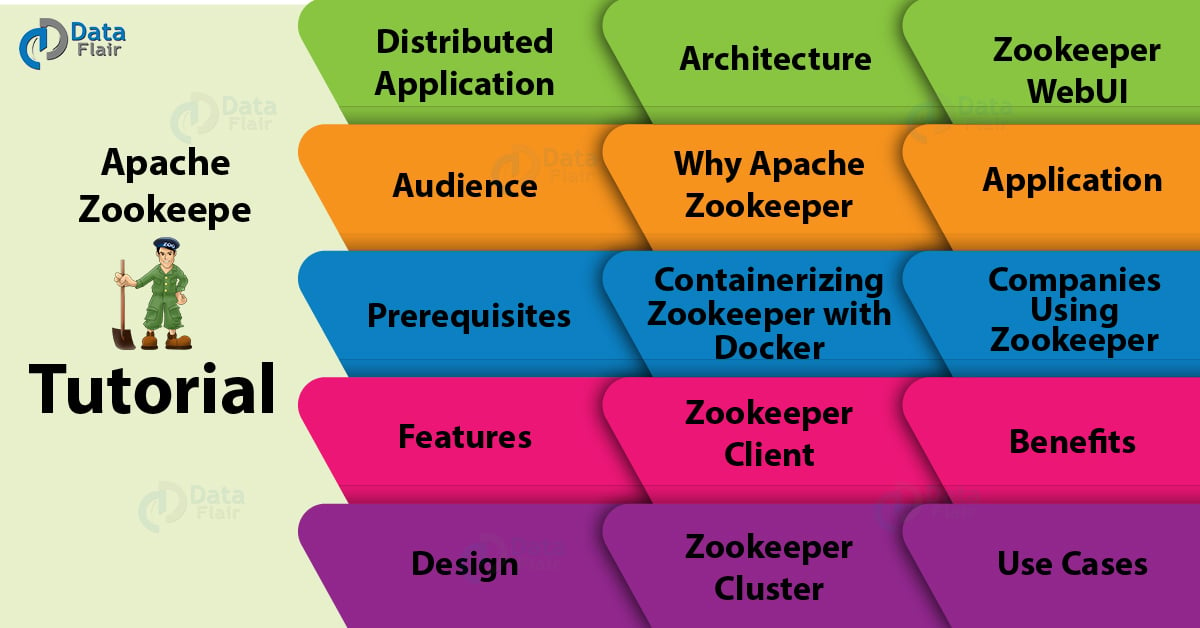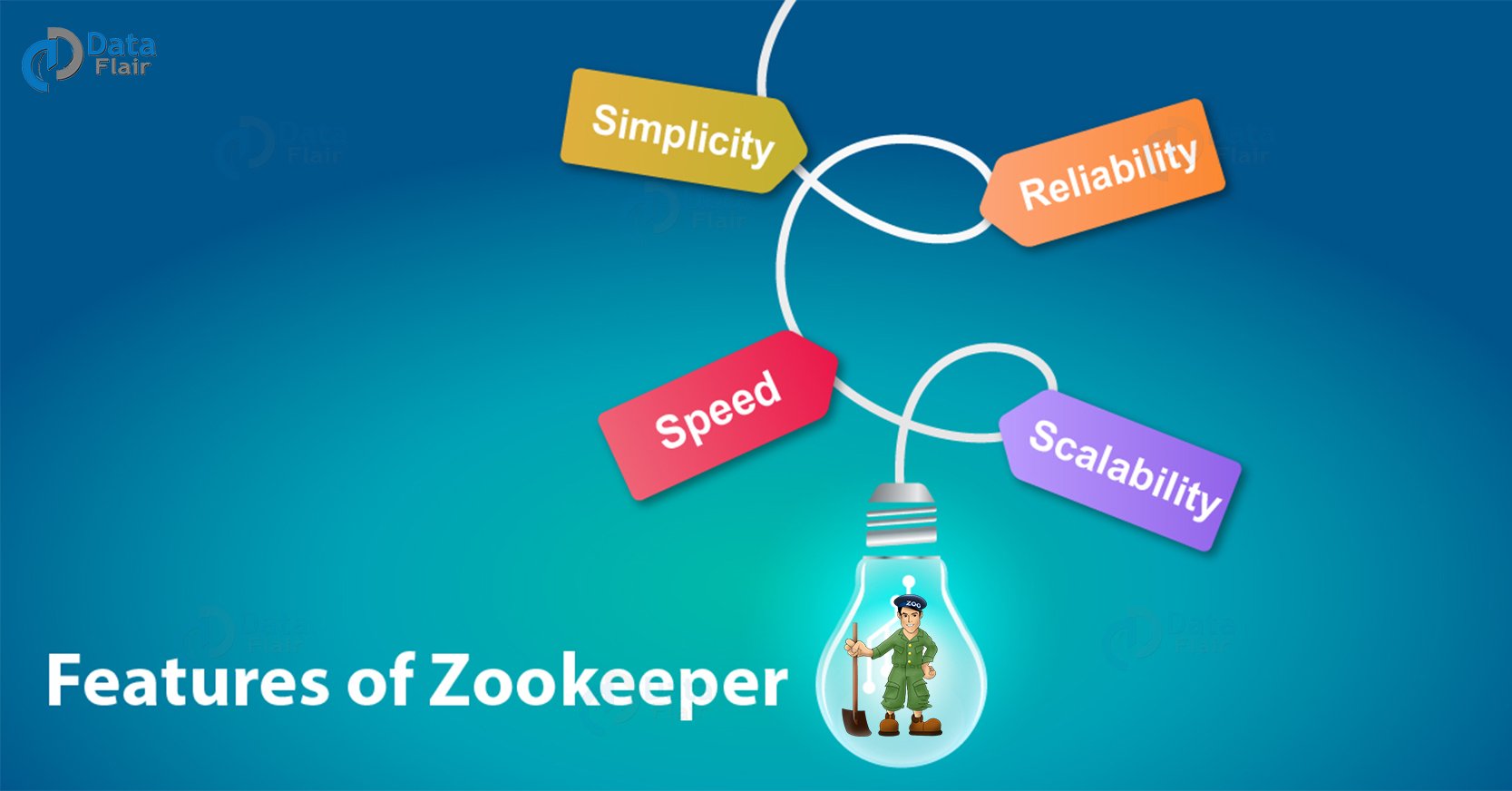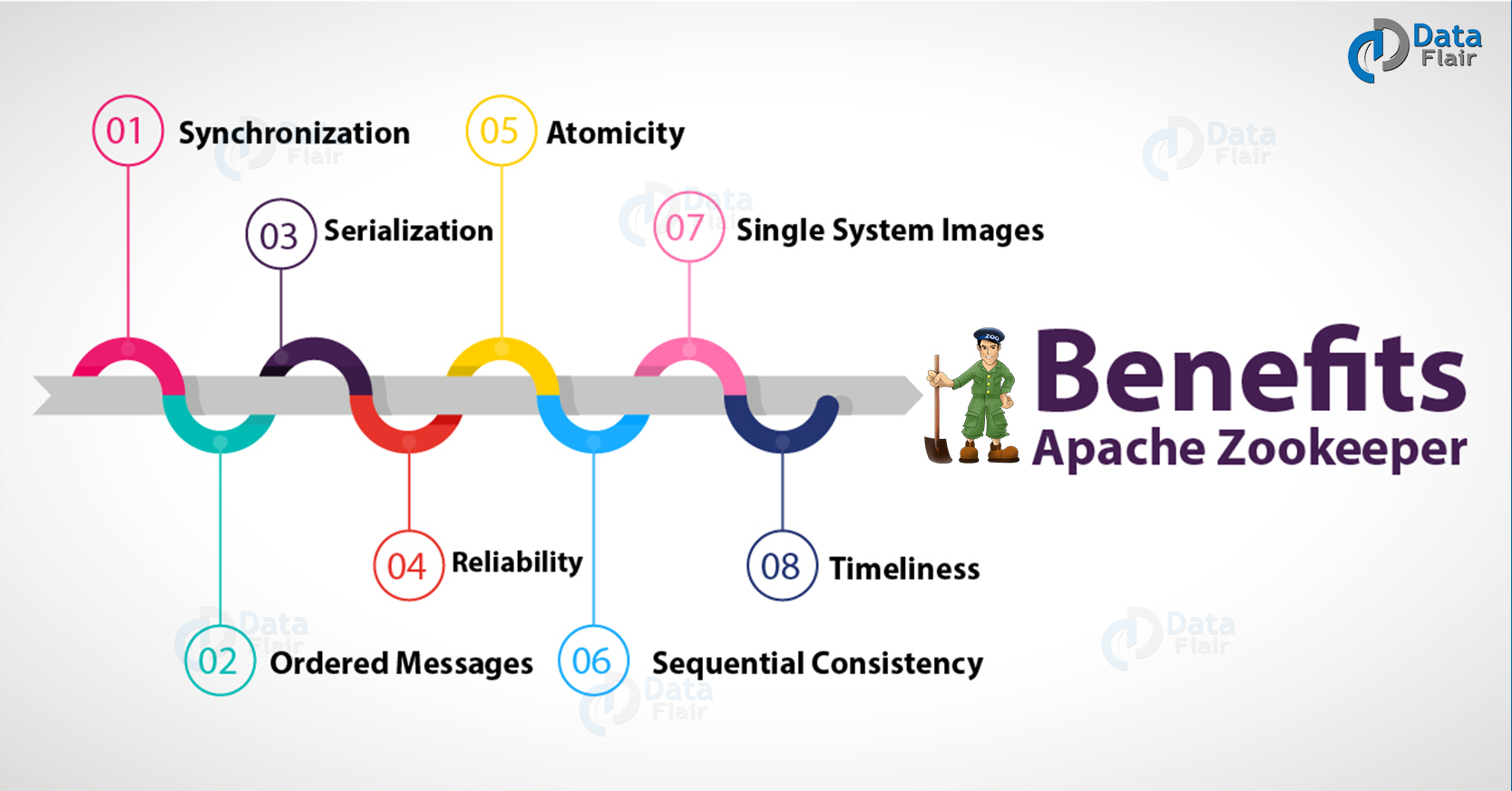Apache ZooKeeper Tutorial – ZooKeeper Guide for Beginners
Today, we are going to start our new journey towards Apache ZooKeeper. In this ZooKeeper Tutorial, we will see the meaning of Apache ZooKeeper and also the popularity of ZooKeeper.
Moreover, we will learn the features, benefits, applications and use cases of ZooKeeper. Also, we will discuss different terms such as ZooKeeper Client, ZooKeeper Cluster, ZooKeeper WebUI.
Along with this, Apache ZooKeeper tutorial will give the answers for why ZooKeeper is used. Also, we will see the companies using ZooKeeper. At last, we will see Apache ZooKeeper Architecture.
Since ZooKeeper is distributed in nature, so it is very important that we know a thing or two about distributed applications, before moving further. Hence, first, we will see ZooKeeper discussion with a quick introduction of distributed applications.
So, let’s start Apache ZooKeeper Tutorial.
What is a Distributed Application?
In order to complete a particular task in a fast and efficient manner, a distributed application can run on multiple systems in a network at a given time (simultaneously). It is possible by their intermediate coordination.
Also, we can say that by using computing capabilities of all the system involved, complex and time-consuming tasks, which will take hours to complete by a non-distributed application (running in a single system) can be done in minutes with the help of a distributed application.
In addition, by configuring the distributed application to run on more systems, the time to complete the task can be further reduced. There is a cluster, which is basically a group of systems in which a distributed application is running.
And in a cluster there are machines running, those machine running in a cluster is what we call a Node.
Generally, Server and Client application are two parts of a distributed application. On defining both:
- Server applications
The Distributed Applications those have a common interface is what we call Server Applications. Basically, it ensures that the clients can connect to any server in the cluster and fetch the same result.
- Client applications
The tools which help to interact with a distributed application is what we call Client applications.
- Benefits of Distributed Applications
a. Reliability
If somehow a single or a few systems fail that does not make the whole system to fail.
b. Scalability
By adding more machines with the minor change in the configuration of the application with no downtime, Performance can be increased as and when needed.
c. Transparency
It simply means that it hides the complexity of the system. Also, it shows itself as a single entity/application.
- Challenges of Distributed Applications
1. Race condition
Sometimes there are two or more machines which are trying to perform a particular task, even when that task actually needs to be done only by a single machine at any given time.
2. Deadlock
In order to complete indefinitely, two or more operations waiting for each other.
3. Inconsistency
It means Partial failure of data.
What is ZooKeeper?
ZooKeeper is a distributed coordination service which also helps to manage the large set of hosts. Since managing and coordinating a service especially in a distributed environment is a complicated process, so ZooKeeper solves this problem due to its simple architecture as well as API.
As its best, without worrying about the distributed nature of the application, ZooKeeper allows developers to focus on core application logic.
Originally, for accessing applications in an easy and robust manner, the ZooKeeper framework was originally built at “Yahoo!”.
But after that for organizing services used by Hadoop, HBase, and other distributed frameworks, Apache ZooKeeper became a standard. For instance, to track the status of distributed data, Apache HBase uses ZooKeeper.
In addition, they can also support a large Hadoop cluster easily. To retrieve information, each client machine communicates with one of the servers. However, in past times most of the work required fixing the bugs at the time of implementation of distributed applications.
Though we can say, these various difficulties in implementations are the main reason behind the creation of ZooKeeper. Because it keeps an eye on the synchronization as well as coordination across the cluster in a nutshell.
ZooKeeper Tutorial – Audience
The professionals those are aspiring to make a career in Big Data Analytics by using ZooKeeper framework, can go for this Zookeeper tutorial. Because this Apache ZooKeeper tutorial will provide enough understanding of how to use ZooKeeper to create distributed clusters, in detail.
ZooKeeper Tutorial – Prerequisites
Although, one must have a good understanding of Java, before proceeding with this ZooKeeper tutorial, since its server runs on JVM, distributed process, as well as Linux environment.
Features of ZooKeeper
There is some best Apache ZooKeeper feature, which makes it stand out from the crowd:
- Simplicity
With the help of a shared hierarchical namespace, it coordinates.
- Reliability
The system keeps performing, even if more than one node fails.
- Speed
In the cases where ‘Reads’ are more common, it runs with the ratio of 10:1.
- Scalability
By deploying more machines, the performance can be enhanced.
ZooKeeper Tutorial – Design
Below, we are discussing some design goals for Apache ZooKeeper:
a. ZooKeeper is simple
While working on ZooKeeper, all distributed processes can coordinate with each other. This coordination is possible through a shared hierarchical namespace. However, it is organized as same as the standard file system.
Here the namespaces which consist of data registers, what we call as znodes, in ZooKeeper parlance. Though, these are as same as files and directories. In addition, ZooKeeper data keeps in-memory, due to that it achieves high throughput as well as low latency numbers.
b. ZooKeeper is replicated
Apache ZooKeeper itself is intended to be replicated over a set of hosts called an ensemble, as same as distributed processes it coordinates.
c. How is the order beneficial?
In order to implement higher-level abstractions (synchronization primitives, Subsequent operations) usage of the order is required.
d. ZooKeeper is fast
Especially, in “read-dominant” workloads, ZooKeeper works very fast.
Apache ZooKeeper Architecture
Below in this Apache ZooKeeper Tutorial, several constituents from the architecture of ZooKeeper, are given such as:
- Server Applications: Through a common interface, these applications facilitate interaction with client applications.
- Client Applications: There are several tools which help to interact with distributed applications.
- ZooKeeper Nodes: These are the systems on which a cluster runs.
- Znode: By any node in the cluster, we can update or modify Znode.
we can easily replicate ZooKeeper services by Hadoop ZooKeeper’s architecture over a set of machines. However, each maintains an image of in-memory data tree as well as transaction logs here.
Moreover, the client applications contact to a single server and also establish a TCP link. So, through them, they send requests, receive responses, watch the events, and many more.
Why Apache ZooKeeper?
Basically, to make coordination between (the group of nodes) and maintain shared data with robust synchronization techniques, a cluster uses an Apache ZooKeeper.
However, for writing a distributed application, ZooKeeper itself a distributed application which provides several services. So, here we are listing the common services offered by ZooKeeper, such as −
a. Naming service
In a cluster, identifies the nodes by name.
b. Configuration management
For a joining node, latest and up-to-date configuration information of the system.
c. Cluster management
In real time, Joining / leaving of a node in a cluster and node status.
d. Leader election
For coordination purpose, electing a node as the leader.
e. Locking and synchronization service
while modifying it, locks the data. while connecting other distributed applications like Apache HBase, this mechanism helps us in automatic fail recovery.
f. The highly reliable data registry
Even when one or a few nodes are down the availability of data.
As there are few complex and hard-to-crack challenges also offered by Distributed applications, so, to overcome all the challenges, ZooKeeper framework provides a complete mechanism. Moreover, using fail-safe synchronization approach, we can handle race condition and deadlock. Also, ZooKeeper resolves the inconsistency of data with atomicity.
Containerizing ZooKeeper With Docker
By using the Docker, we can also containerize ZooKeeper. So, as a big benefit with this, it is possible to add and remove the nodes on demand. Though, it is only possible by adding ZooKeeper in the Docker image and also running the container using this on every master of the cluster.
In addition, it should either create a cluster independently or it should be able to connect to an existing cluster and be a part of it, during the starting of a container. Hence, it allows dynamic reconfiguring of the entire Hadoop cluster using the Docker containerization, as a benefit of using the Docker container.
What is ZooKeeper Client?
Like all distributed application, Zookeeper distributed application also consists of the server and client. It has a centralized interface by which clients can connect to the service. However, these clients could be command line or a GUI client.
Basically, the tools that are available for interacting with the ZooKeeper distributed application, is what we call ZooKeeper client applications.
What is Zookeeper Cluster?
As we need to have the ZooKeeper infrastructure in the cluster mode in order to have the system at the optimal value when we are running the Apache ZooKeeper at scale. We also call the ZooKeeper cluster an ensemble.
Although, make sure the majority of the cluster nodes need to be up and running at all times if the ZooKeeper cluster has to be running successfully.
ZooKeeper WebUI
Basically, to work with ZooKeeper resource management, the ZooKeeper WebUI or Web user interface is an easier way.
Hence, the WebUI allows working with ZooKeeper using the web user interface, instead of using the command line to interact with the ZooKeeper application. So, we can say it makes it easier and efficient to work.
Apache ZooKeeper Applications
Simply put, for creating highly available distributed systems at scale, it has become one of most preferred choice. Hence, one of the most successful projects from the Apache foundation is the ZooKeeper project.
Apache ZooKeeper has allowed the companies to function smoothly in the big data world by providing a solid base to implement different big data tools. Thus, it is one of the most preferred applications to be implemented at a large scale, because of its ability to provide multiple benefits at once.
Companies Using ZooKeeper
Now, in this Apache ZooKeeper tutorial, we are providing a list of companies using ZooKeeper:
- Yahoo
- eBay
- Netflix
- Zynga
- Nutanix
Benefits of Apache ZooKeeper
There are various ZooKeeper Benefits, such as −
a. Synchronization
It allows mutual exclusion as well as cooperation between server processes. So, that helps in Apache HBase, for the purpose of configuration management
b. Ordered Messages
By stamping each update with a number denoting its order, it keeps track.
c. Serialization
It ensures that our application runs consistently. To coordinate queue to execute running threads, this approach can be used in MapReduce.
d. Reliability
Once it applies the update, it will persist from that time forward until a client overwrites the update.
e. Atomicity
No transaction is partial, either data transfer succeeds or fails completely.
f. Sequential Consistency
In the same order that they were sent, it applies the updates from a client.
g. Single System Image
Regardless of the server that it connects to, a client will see the same view of the service.
h. Timeliness
Within a certain time bound, the client’s view of the system is up-to-date.
ZooKeeper Use Cases
Some of the most prominent use cases of ZooKeeper in Apache ZooKeeper tutorial are:
- Managing the configuration
- Naming services
- Choosing the leader
- Queuing the messages
- Managing the notification system
- Synchronization
By using the ZooKeeper CLI, we can also communicate with the ZooKeeper ensemble. Basically, that gives us the feature of using the various options. Also, there is dependence on the Command Line Interface, for the sake of debugging.
So, this was all in Apache ZooKeeper Tutorial. Hope you like our explanation.
Conclusion
Hence, in this Zookeeper tutorial, we have seen the concept of Apache ZooKeeper in detail. Moreover, we discussed meaning, benefits, features, use cases, and architecture of Zookeeper. Also, we saw different terms as ZooKeeper Client, Zookeeper Cluster, ZooKeeper WebUI.
At last, in Apache ZooKeeper tutorial we discussed Zookeeper with docker. Next, we will see Features of ZooKeeper. Still, if any doubt occurs regarding Apache ZooKeeper tutorial, feel free to ask in the comment section.
Did you like our efforts? If Yes, please give DataFlair 5 Stars on Google






